What is Biogas?
Composition and use of biogas
methanization , that is, organic substances (vegetable or animal substances) decomposition ) or anaerobic digestion of domestic waste, It produces a gas called biogas. This, methane (CH4) (usually between 50% and 70%) carbondIoxide , at a low rate hydrogen sulfide (responsible for the odor of this gas) and in varying concentrations of water vapor is a mixture. Biogas, especially in swamps and in the wastelands in the atmosphere naturally can be produced. Also, especially wastewater and sludge treatment in the digesters during artificially is synthesized. in the food industry is also available.
Shares of biogas
Institutions, according to international climate scientists, the global climate change in recent years has been focusing on biogas for several years, as it is a part of In France, since the publication of the decree dated 9 September 1997, recycling biogas in waste land It is mandatory. Biogas recycling is of ecological interest as it could be an alternative to fossil fuel power. Therefore, economic activity linked to biogas is being developed: in 2012 there were 214 production facilities, while at the end of 2013 this number was 848. If it is not recycled, it must be incinerated. The main reasons for recycling or disposal are its toxicity, explosiveness and large volume.
Properties of biogas and its effects on health
Biogas is a flammable gas because it consists mostly of methane, but hydrogen sulfide and caustic because it contains a gas toxic is a gas. The digestive process involves the movement of bacteria and particles, which can lead to a variety of effects in humans. Therefore, an optical flame detector such as the Spyglass SG50 is ideal for detecting methane, avoiding the risks of methane, especially thanks to the color video option.
in the eyes (conjunctivitis) and nasal (cold) irritations and nausea are symptoms of high levels of exposure over a short period of time. Chronic exposure does not cause death, but rather effects the brain (headaches and chronic fatigue) or the digestive system (abdominal aches and nausea). organ failure leads to . Risks to humans are quite minimal if all basic precautions associated with activity around this gas are taken.
Precautions and protection tools against biogas
- Since biogas is explosive, a 4-gas detector, such as the X-am 2500 portable gas detector, enables monitoring of biogas concentrations
- To obtain an accurate analysis of changes in biogas concentrations, the use of specialized equipment such as the Biogas 5000, a biogas analyzer, should be preferred over conventional gas detectors (fixed or portable) that may not be able to monitor such significant concentrations.
- Because biogas contains very high concentrations of H2S (sometimes up to 10,000 ppm) and asphyxiating gases (such as CH4 or CO2), a protective air-purifying mask is not suitable and an atmosphere that provides respiratory protective equipment (a self-contained breathing apparatus or airway system) is required. will be heard.



